| March | ||
| April | May | June |
| July | August | September |
| October | November |
Thursday, 7 November 2024

Elephant ear, Colocasia, trimmed and ready to be packed away for winter storage.
Wednesday, 6 November 2024

Temperatures have dipped below freezing at night. Elephant ear, Colocasia, clearly unhappy.

Ditto my hardy Japanese fiber bananas, Musa basjoo. Not woody, this is all herbaceous growth.

Cut down, and Doug, my intermittent handyman, will drag the debris to a discard pile in the woods.
Then cover the stumps with tubs filled with fallen leaves and heap even leaves more over the tubs.

Wednesday, 9 October 2024

The weather is bound to get cold. The potted red spot bananas have been moved indoors.
Tuesday, 8 October 2024

Angel trumpet, Brugmansia, has just flush after flush of huge fragrant flowers.

Saturday, 5 October 2024

End of summer / early autumn flowers: monkshood, wolfsbane, Aconitum

and goldenrod, Solidago, a sunny flowered native perennial.
Friday, 20 September 2024

One common name for colchicum is "son before the father," an obvious confusion for a bulb that
flowers in the fall but develops seed in the spring. Wrong sequence, with winter coming between.
Sunday, 15 September 2024

Beauty berry is an appropriate common name for Callicarpa, with its clusters
of vivid violet berries. One year a chipmunk assiduously harvested them, this year
it was a small bird. Or perhaps several little birds. Anyhow it was one at a time.

This shrub, Lespedeza, also has a violet purple display but flowers, not fruit.

Seven sons, Heptacodium miconioides, is a small tree that grows in light shade,
flowering later in the growing season. Welcome in BelleWood Gardens, easy to grow but

not easily found - for sure absent from the big box stores. I'll try softwood cuttings.
Friday, 13 September 2024

It is always a pleasant surprise when Colchicum bournmuelleri makes its end of season

appearance, flowers suddenly growing sans foliage. They make a good cut flower too, unlike crocus.
Wednesday, 11 September 2024

Brugmansia has yet another flush of its sweetly scented flowers.

Mirabilis longiflora, flowers open for a night, wither with the morning sun.
Tuesday, 13 August 2024
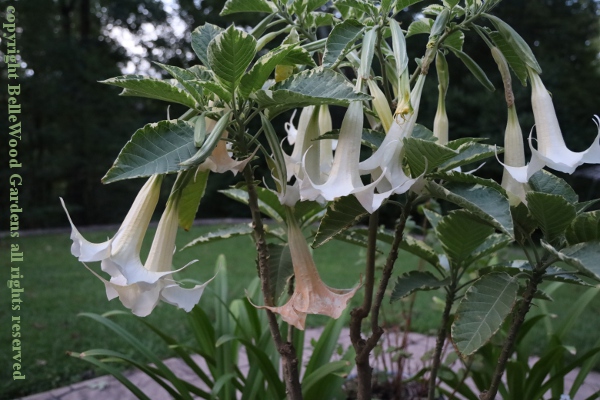
The angel's trumpet is in flower as well as I have ever seen it, deliciously fragrant in the evening.
Thursday, 8 August 2024
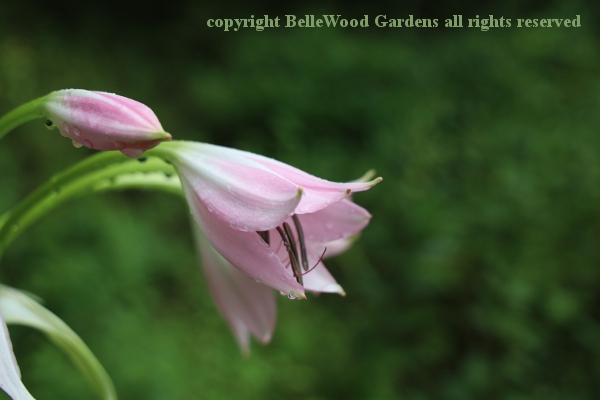
Crinum ×powellii
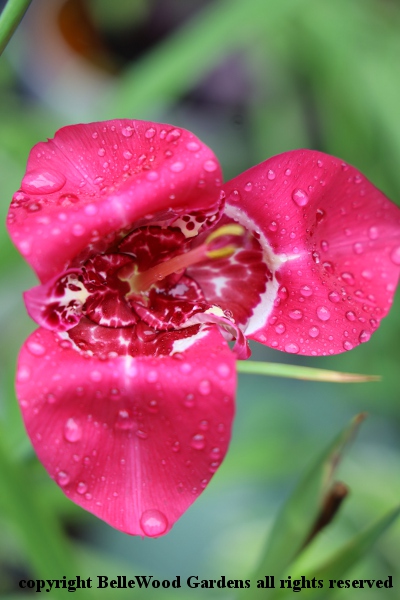
A spatter of rain embellishes Tigridia pavonia
Tuesday, 23 July 2024

Cardinal red, just like the bird. Lobelia cardinalis. And just as you might expect
hummingbirds are indeed attracted to the flowers, come and sip their nectar.
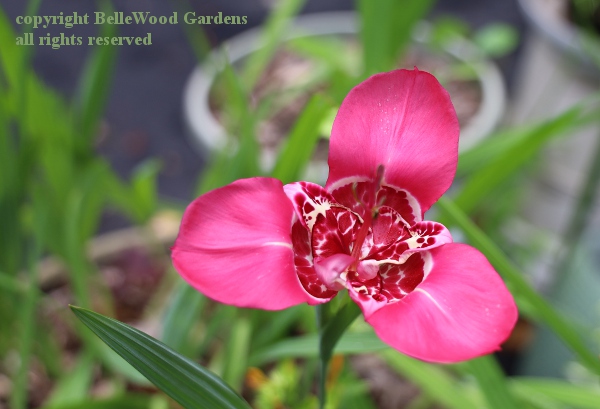
Another Mexican shellflower, this one with a vivid cerise pink flower. So far the deer are ignoring them.
Monday, 22 July 2024
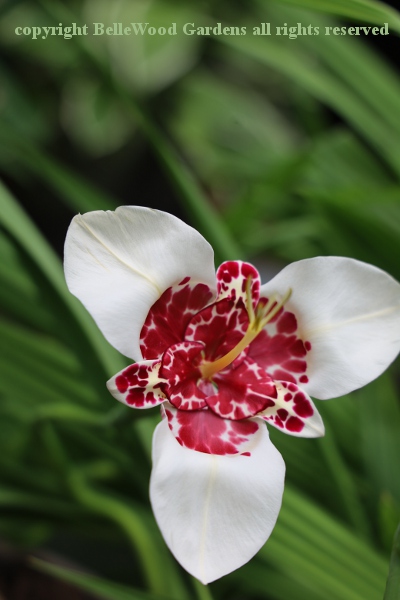
Mexican shellflower, peacock flower, tiger flower are common names for Tigridia pavonia.

Red spot banana, Musa sumatrana 'Zebrina'. Even more handsome from above.
Saturday, 20 July 2024
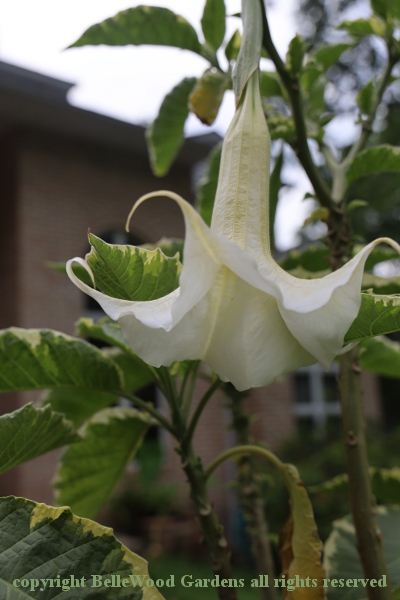
Looking similar to datura in its flower, but angel trumpet, Brugmansia is a woody perennial.
 .
.
Another four o'clock. This cultivar is Mirabilis 'Orange Crush'. I raised it from seed several years ago.
The tubers are stored dormant over winter. They awaken in spring, are watered, enjoyed each summer.
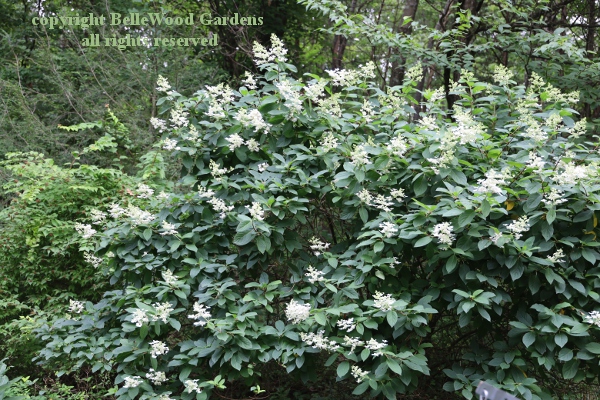
The lacy white flower trusses of Hydrangea panniculata make a pleasant display in mid-summer.

Bottlebrush buckeye, Aesculus parviflora, is popular with butterflies
such as this black swallowtail.
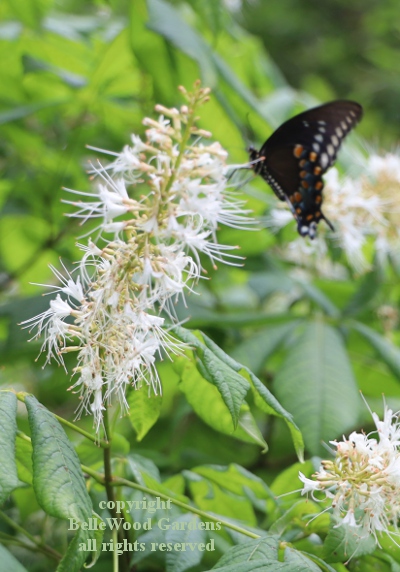
Thursday, 18 July 2024

Native to the southeastern United States, bottlebrush buckeye, Aesculus parviflora. I raised this from seed.
 .
.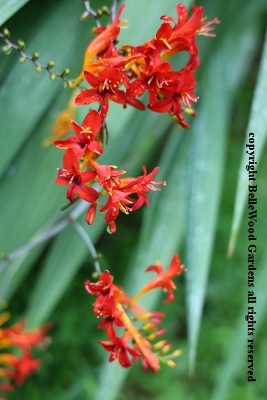
Crocosmia 'Lucifer' continues to flower, vividly. I wonder, do hummingbirds - who like red tubular flowers - come to feed?
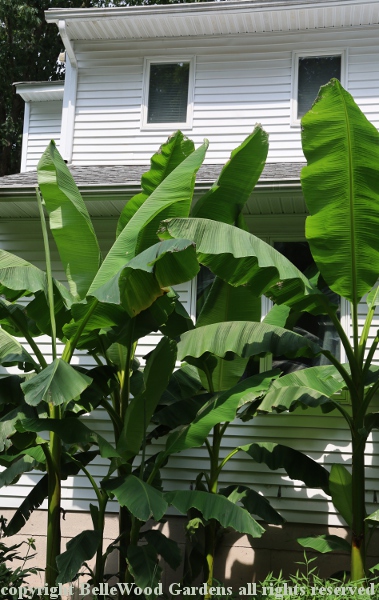
Very summer weather, hot and humid. People may not like it but Musa basjoo clearly does.
To be expected with its common name of mountain mint, Pycnanthemum virginianum
Tuesday, 9 July 2024
Consider the leaf. Published some time ago, that's actually the title for one of my books.
Wednesday, 3 July 2024
Tuesday, 17 June 2024
This year I never got to see more than a couple of the daylilies, ditch lilies, whatever you care to name them. Why?
Because the deer browsed both flower buds and foliage of the Hemerocallis fulva at the bottom of my driveway. This is a first. And others growing elsewhere along the roads have been ignored. comeuppance. I thought I was good.
Sunday, 9 June 2024
I have semi hardy bananas that winter over with protection, and another .
Saturday, 8 June 2024
Thursday, 9 May 2024 Friday, 3 May 2024 Wednesday, 1 May 2024 Tuesday, 30 April 2024
Friday, 19 April 2024 Wednesday, 11 April 2023 Pieris, lily of the valley shrub, is a popular shade tolerant deer resistant evergreen shrub with panicles of small white flowers in early spring.There is Pieris floribunda which is a native to southeastern United States, for some reason it is the Japanese P. japonica that is widely available. Why so? I have no idea.
It has been a typical season, which is to say it seems confused. First we had some pleasantly mild weather. Then, according to the calendar spring arrived on 19 March. Whereupon the weather turned chilly and very windy. Ah well.
The neighbor's sheep are lambing.
Finns usually birth twins. Or better. Definitely "better" this year, as one ewe had triplets and another had quadruplets! At least the precipitation on 23 March arrived as 2.73 inches of rain and not better than two feet of snow.
Friday, 22 March 2023 Sunday, 3 March 2023 I am very appreciative of hellebores. What's not to like - they grow in shade, are evergreen
Of course, what we anticipate as the first flowers are not perennials, but bulbs.
Deer tend to leave both galanthus and leucojum alone. Crocus are a different matter.

has mint scented leaves. It likes average to moist soil and spreads with underground roots.
Flowers attract insects including various bees, wasps, flies, small butterflies, and beetles.
Silvery bracts provide an extended period of interest, even before
mountain mint is in flower. And yes, the leaves may be used for tea.

Crocosmia ×crocosmiiflora 'Lucifer' is probably the hardiest of the crocosmia. Surprising
that any are hardy, the species is native to the grasslands of southern and eastern Africa.
Fiery red flowers on horizontally branched stems add early summer color to my garden.
Flowers come and go, foliage adds interest throughout the gardening season. For example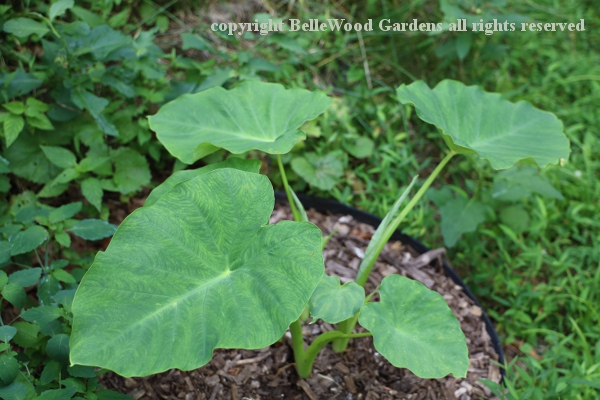
Bold texture of elephant ear adds interest to the summer garden. This one is a Colocasia,
easy to distinguish from Alocasia How so? Here the leaves point down towards the ground,
not up to the sky. Winter dormant, tubers easily stored dark, dry, and frost free in basement.
Amorphophallus provides texture and contrast. Tender, when frost knocks it back
I dig the tubers, pack in peat moss, and store dormant in basement or garage. But
that's after summer-long interest provided by foliage that deer refuse to eat.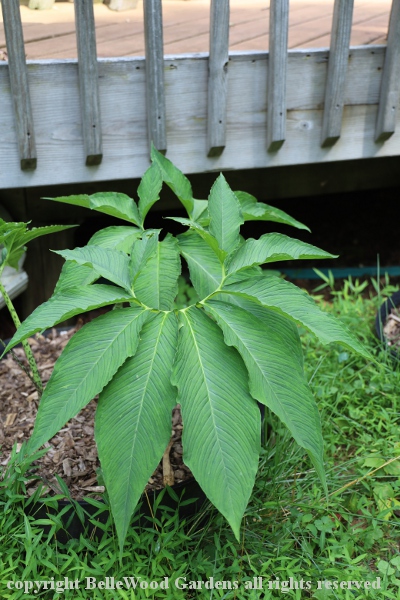
Voodoo lily, Sauromatum venosum, has offered me a conundrum. For a few years
it wintered over quite nicely in the garden. Multiplying too. Then one spring - gone.
All of them. Ah well. Easy enough to dig and store the dormant tubers. Well worth
such easy effort, after the pleasure of this lush, exuberant foliage all summer long.
Bold and tropical, lovely burgundy markings on Musa sumatrana 'Zebrina', aka 'Rojo'.
A relatively modest size, for a banana that is. No winter dormancy, the pots are wheeled
indoors with a hand truck and then spend the cold months under the great room skylights.
They pale to midgets when compared to my hardy Japanese fiber banana. And yes,
Musa basjoo does winter over. Not as you see it here. This is seasonal growth.
Cut back close to the ground, well covered with dry leaves and plywood covers.
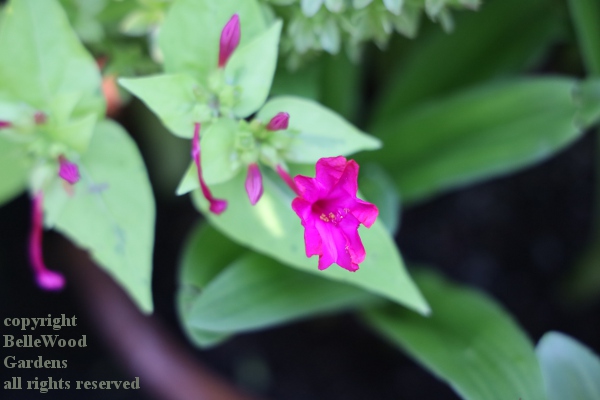
I do like Mirabilis 'Limelight' with its chartreuse leaves and vivid magenta flowers that open
towards dusk, then close in morning. It is in a pot with a nearby butterfly weed, Asclepias syriaca.

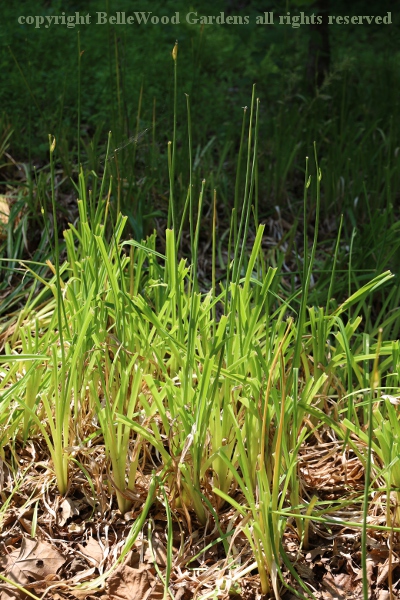
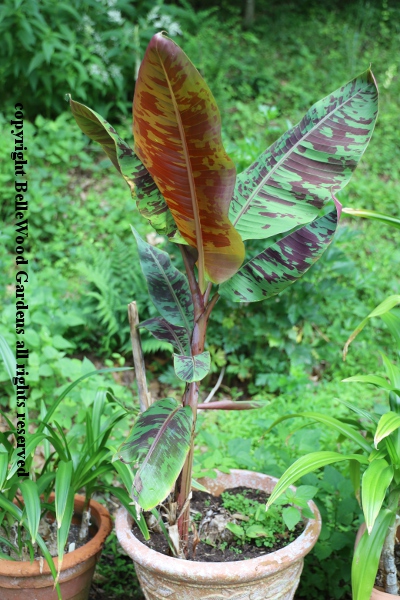
that is too tender for that. The red spot or blood banana, Musa zebrina 'Rojo'
has green leaves with burgundy wine markings on the top and red beneath.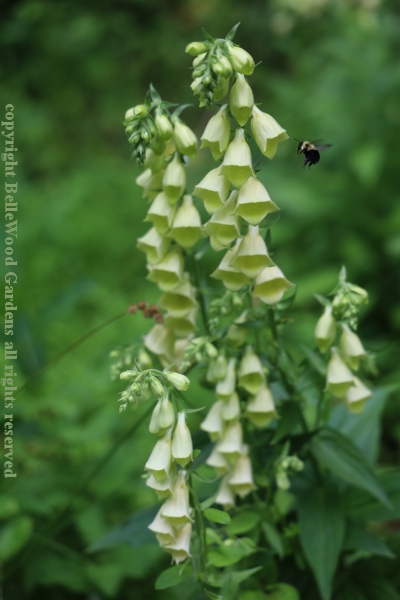
I do like Digitalis lutea with its soft yellow flowers that has self sown
up, down and across the slope. And the bees like it too, as you can see.

I thought this was Eucomis pole-evansii Someone told me is is E. pallidiflora.
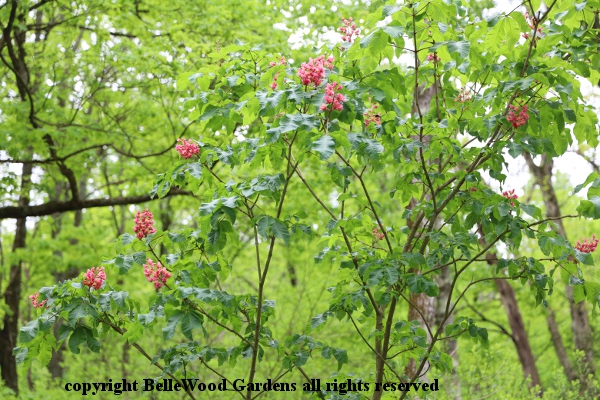
My red buckeye, Aesculus pavia, are in flower. It makes me especially happy as I raised them from seed.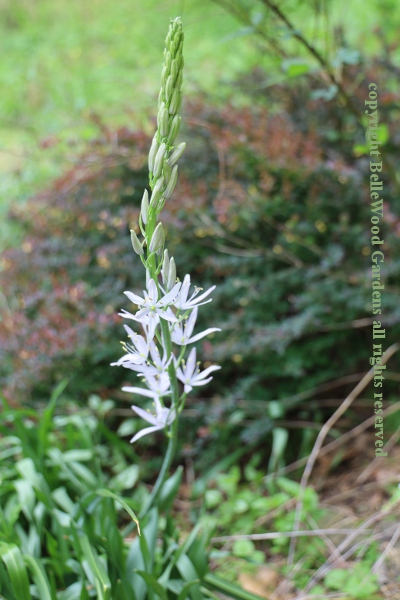
Always reliable, Camassia cusickii is in flower. People may eat the bulb.
Deer leave above ground portions alone, as do rabbits. No complaints.
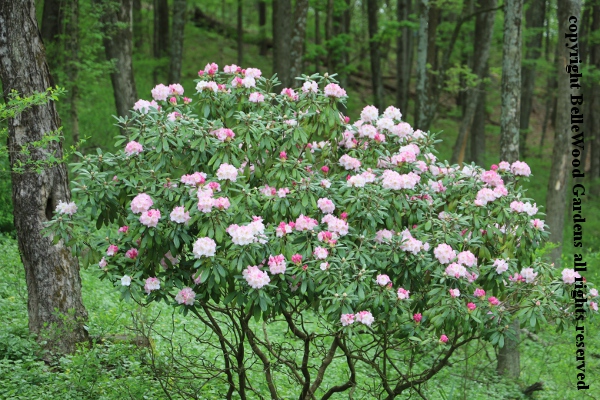
Moderate temperatures, some sunshine with broken clouds have coaxed Rho. yakushimanum into full bloom.
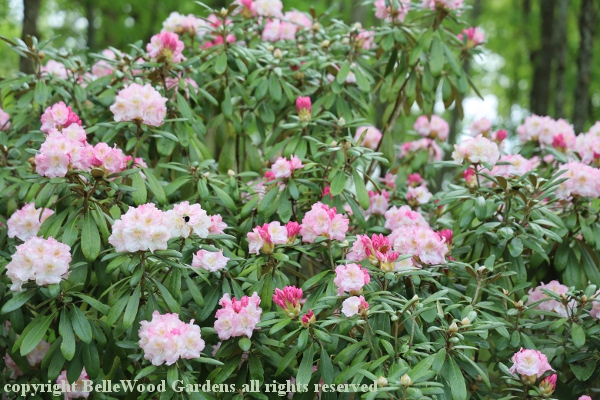
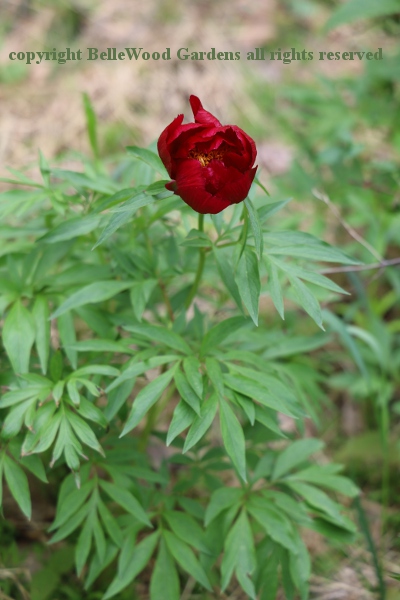
Paeonia 'Early Scout' makes a bright display with its vivid scarlet flowers.
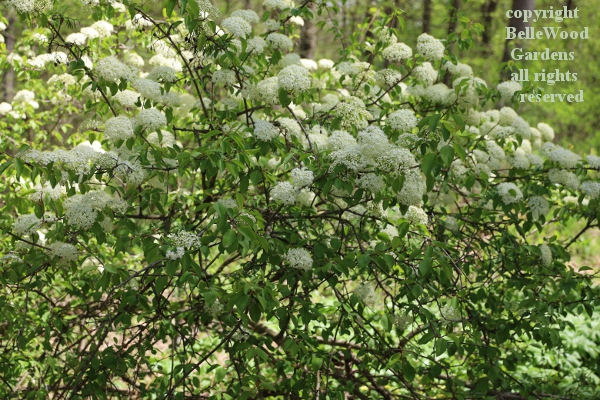
One of our native viburnums, V. nudum, is massively in bloom. Here's hoping fruit set
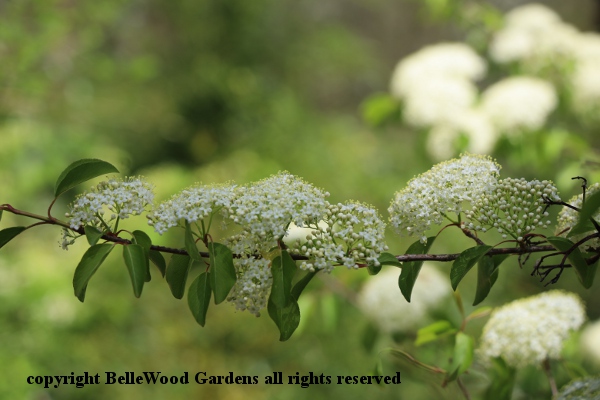
will be equally as prolific. Birds love them, even though the largish seed means that
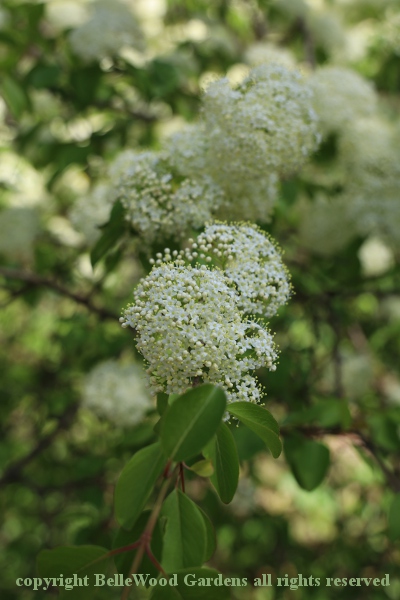
there is a relatively small amount of pulp relative to the size of each berry.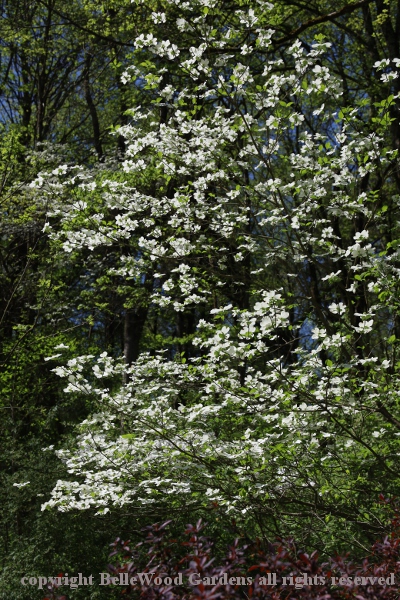
Backlit, the dogwood flowers are illuminated into translucency.

The dogwoods, Cornus florida, are superb this year, as fine as I've seen them in the time
we've lived here at what is now BelleWood Gardens. Wild ones, planted by nature, not me.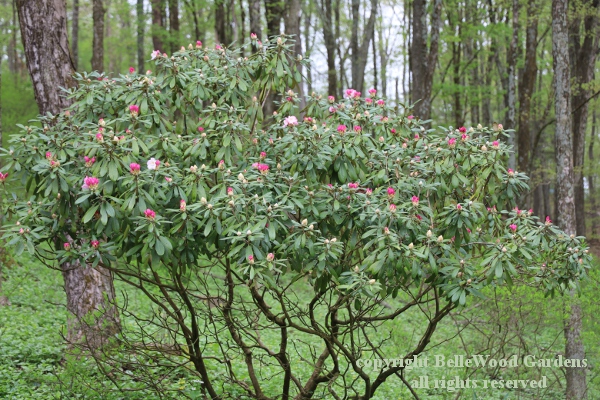
Rhododendron yakushimanum came to me from my friend and mentor John Osborne's garden
in Connecticut after he died. I think of him each spring as deep pink buds open apple blossom pale.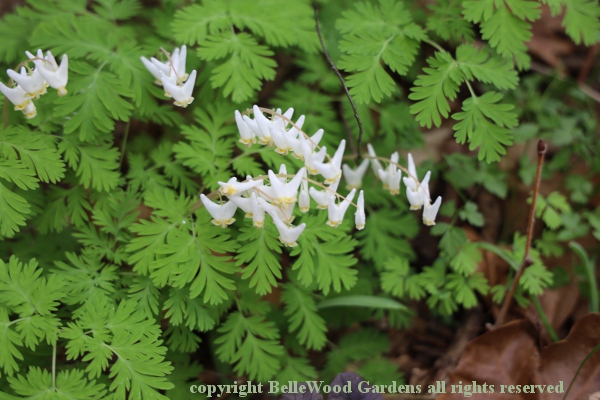
Like tiny pantaloons hung on a line to dry, flowers of Dutchman's breeches, Dicentra cucullaria
Bleeding heart, Dicentra spectablis, is their non-native Asian counterpart,.
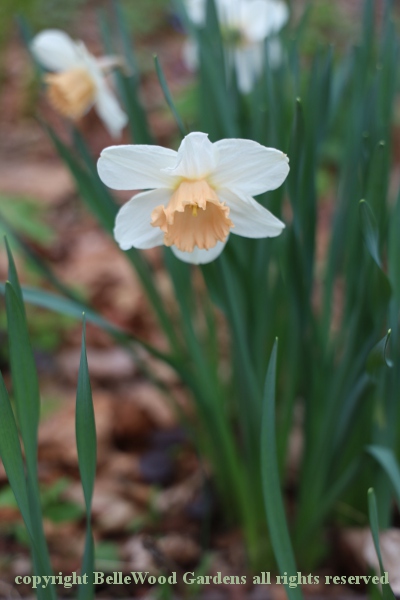
No idea of the name but this elegant daffodil with crisp white petals and
wide, apricot pink cup is a reliable performer in the woods each spring.
I am amused each year when summer snowflake, Leucojum aestivum,
comes into flower. Yes, yes, this is later than the early March flowers of
spring snowflake, L. vernum. But summer? Come now, summer? Really?
I do love this Japanese woodland primrose, Primula kisoana.
The flower of Trillium sessile, like a dark maroon candle flame over mottle leaves.
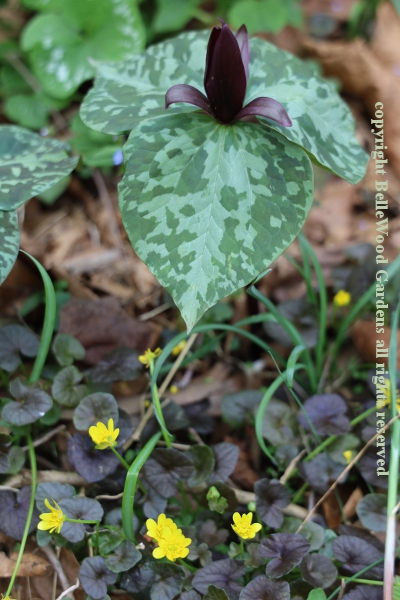
An accidental pairing with the rather invasive Ranunculus ficaria 'Brazen Hussy'
(a gift from Pamela Harper) whose dark leaves echoes and enhances the trillium's flower.
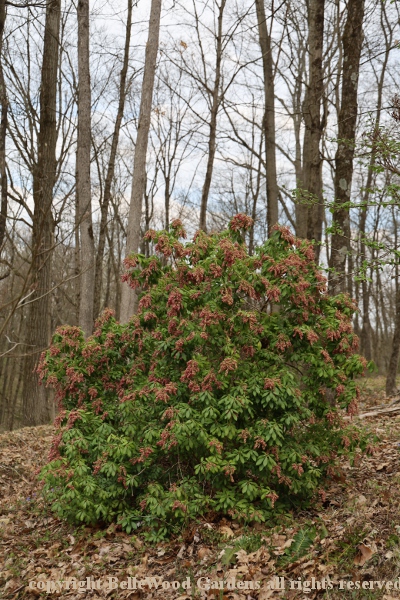
Of course there is always something different. This is P. japonica 'Valley Valentine' which has
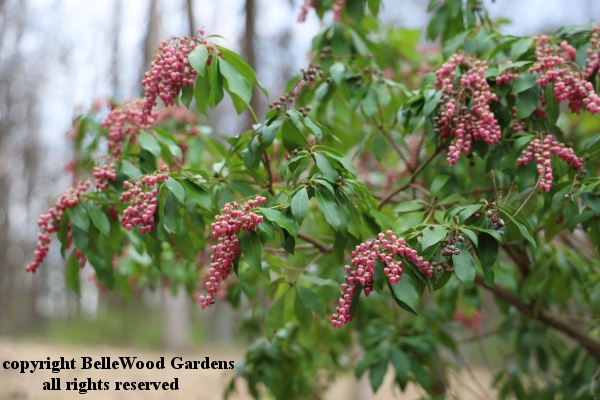
the trailing racemes of flowers but rather than white the cultivar has rich rosy pink flowers.
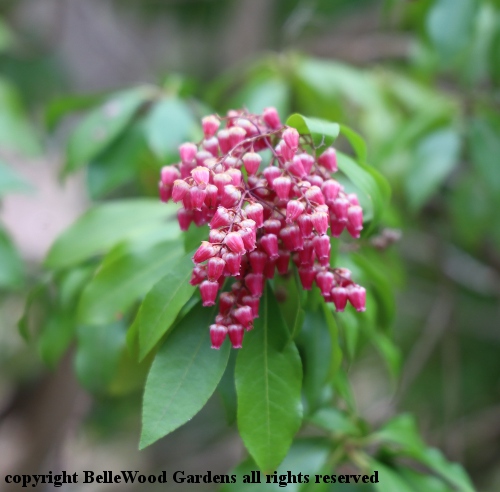
It is, I think, most attractive when viewed close to, rather than at a distance. Do you agree?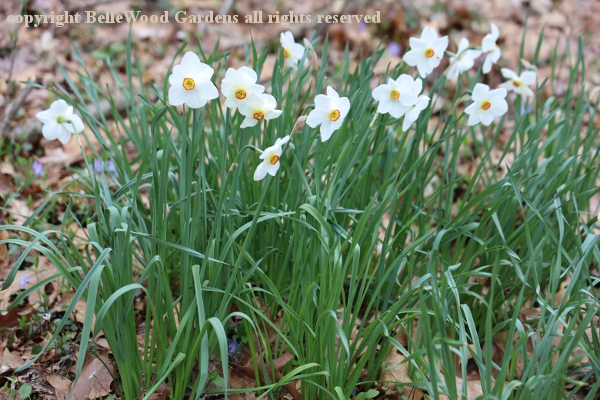
I planted these Narcissus poeticus daffodils a couple of decades ago. Several cultivars. They
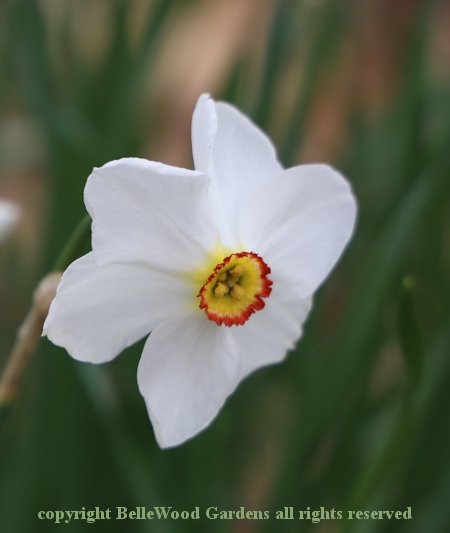
all have glistening white petals and a brief ribbon of a cup banded green to yellow,
and edged with red. Over time, labels have been lost. No idea which look-alike is which.
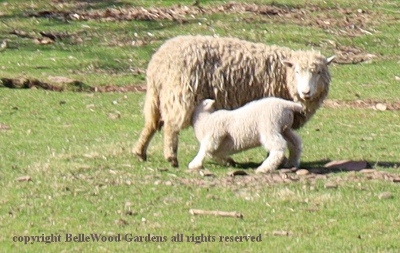
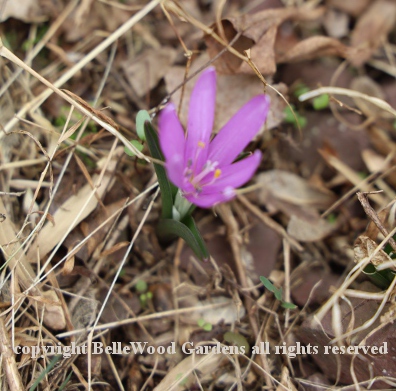
Not a crocus. This is Bulbocodium vernum, the spring flowering relative of
the autumn colchicums. Not that they are as well known as they should be either.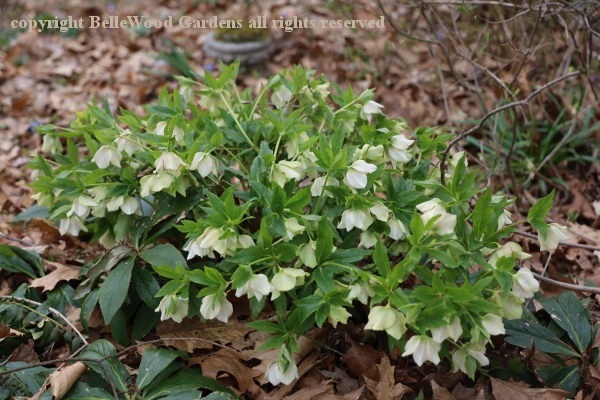
The hellebores are thriving, as may be seen from this sizable Helleborus ×orientalis plant.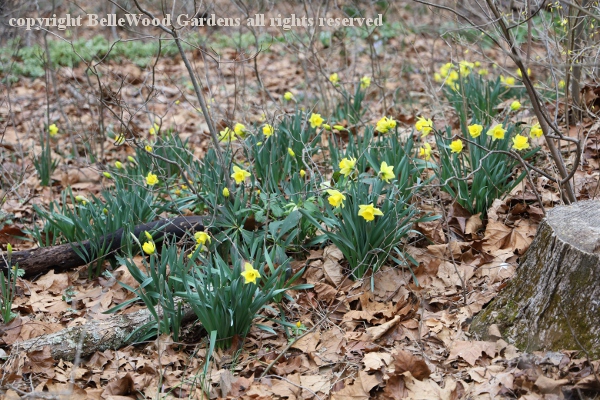
Daffodils are emerging. Here is the early blooming Narcissus 'Rijnveld's Early Sensation'.
Narcissus 'Ice Follies' is straightening up, after a night in the 20s Fahrenheit laid then down.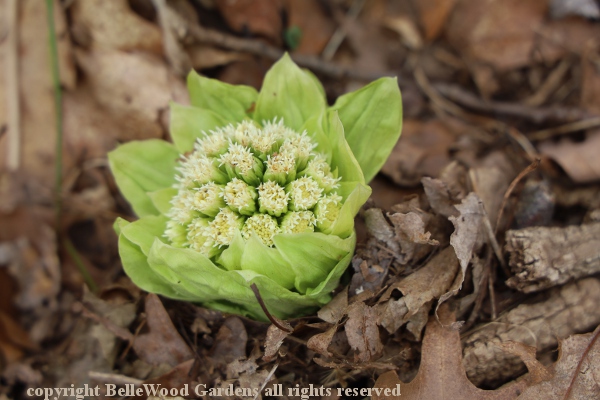
Japanese butterbur, Petasites japonicus is an escape artist. It was planted in a cast iron bathtub
with three layers of screening over the drain opening. Took it a while, but it got out. It is edible.
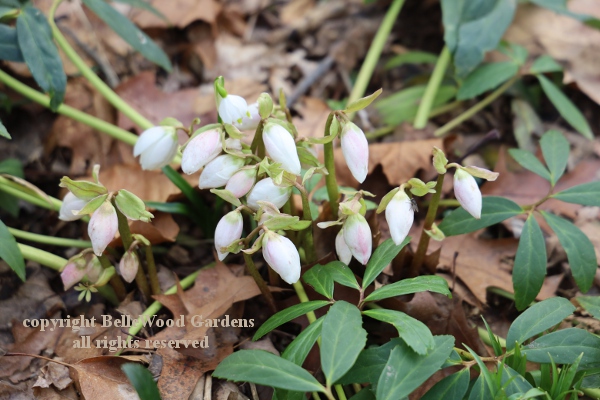
and the deer don't eat them. Here's a Christmas rose (yes, I know, it's well after Christmas
and not a rose) Helleborus niger, well budded and ready to open. Such a great perennial.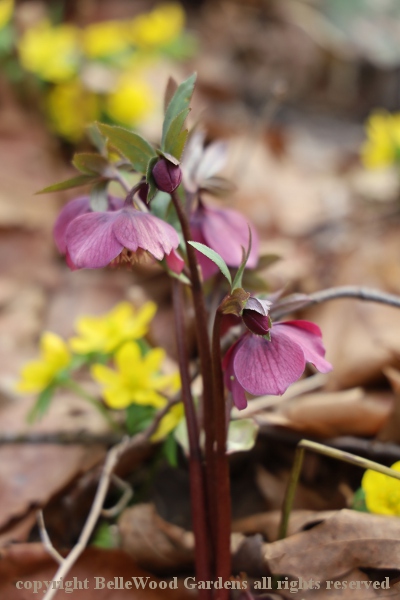
And this is Helleborus orientalis subsp. abchasicus in the Early Purple Group. It flowers
somewhat earlier than the straight species, closer to the time of the Christmas rose, H. niger.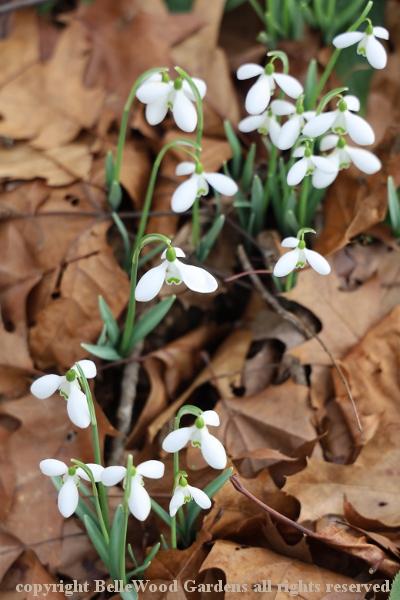
They've store food underground, ready to hurl themselves into flower, even the littlest ones
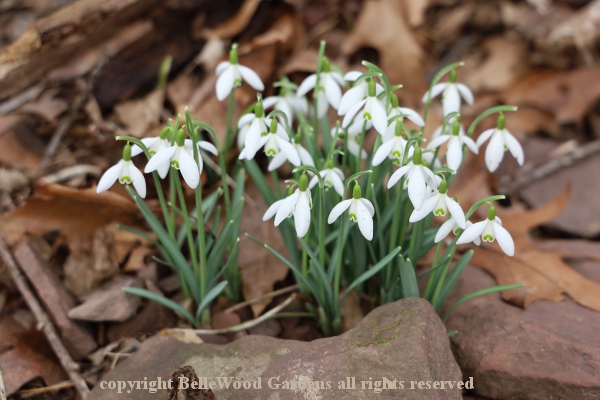
such as snowdrops. Look closer, enjoying these harbingers of spring, there are differences.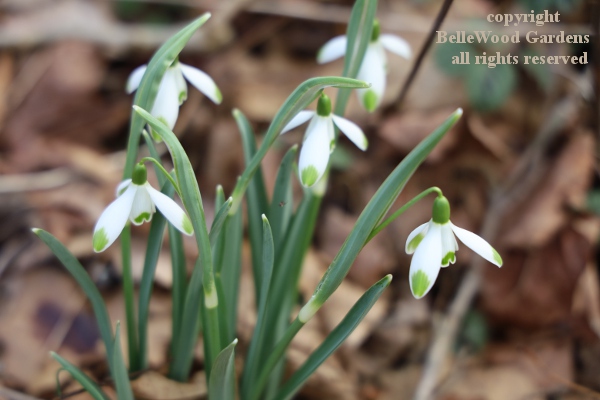
For example, Galanthus nivalis 'Viridi-apice' has elegant green markings on its outer petals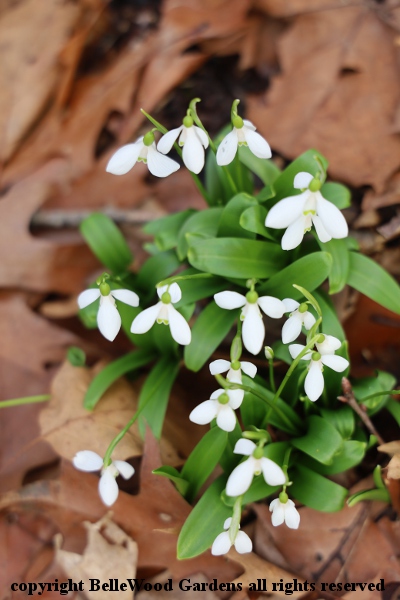
while Galanthus woronowii has bright green leaves rather than the grayish green of G. nivalis.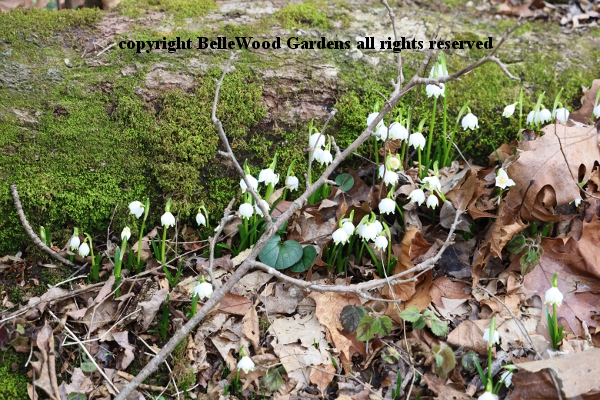
And this is not a snowdrop but rather a snowflake, Leucojum vernum with flowers like a
bell, or a starched petticoat. But again with dainty green markings as embellishment.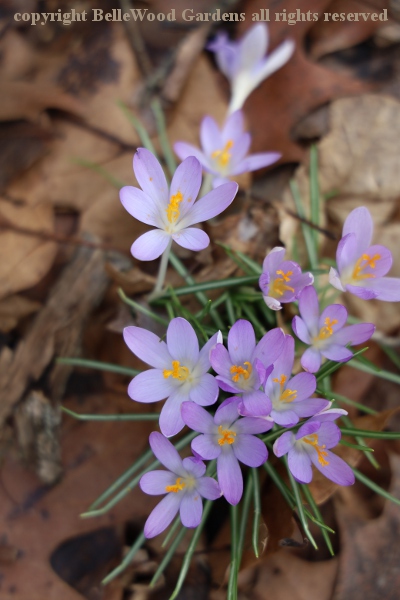
And, while crocus usually want to grow in full sun with well drained soil, here's one for the woods.
Crocus tommasinianus not only grows in some shade, deer do not seem to include it in their diet.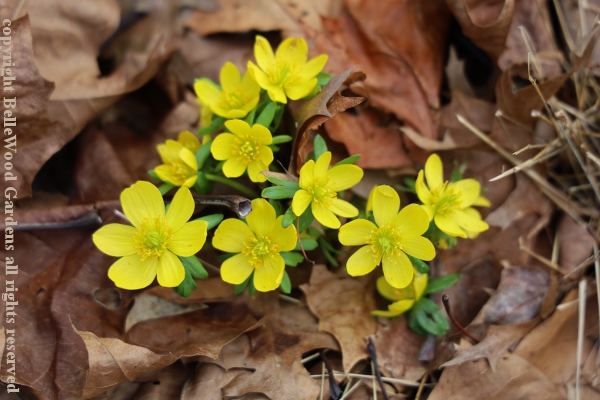
Last among the little bulbs I want to share with you today - yes, I know, not a true bulb.
Winter aconite, Eranthis hiemalis, is a tuber. Quite small tubers. That resent the drying
that occurs in preparation for shipment. Plant a couple of dozen (they're inexpensive) and
rejoice in the few that do appear in spring. Because, you see, they'll reseed very well, so
soon you'll have carpets of their bright yellow flowers cheerfully spreading in the garden.